Sehwag is one of India’s most loved cricketersThe biggest reason behind the fan following of any sport is undoubtedly the amount of entertainment it provides. More the entertainment, more are the number of fans. This theory holds true in the game of cricket as well, which is proved by the modern affinity towards T20 cricket which is a pocket-sized spectacle as opposed to the five-day affair of Test cricket.As the game has evolved, the focus has shifted towards seeing batsmen hitting the bowlers all around the park instead of watching an even battle between bat and ball. One of the earliest exponents of aggressive batting was the legendary Sir Viv Richards. His very presence at the crease meant that the bowlers would soon go on a leather hunt, and he proved that the batsmen could dictate the flow of the game.The prospect of a single batsman changing the flow of the game was infectious, and almost every team began to use it as a guideline. Over the years, batsmen trying to be aggressive succeeded and failed in equal measure, and it wasn’t until the 1996 World Cup when Sanath Jayasuriya revolutionized the role of the opening batsman, and the game was changed forever.Cricket has seen its share of quick-scoring batsmen come and go – Jayasuriya, Gilchrist, Afridi and Gayle among others, but perhaps nobody has reshaped the modern game like India’s maverick Virender Sehwag.After several good performances for Delhi in the late 90s, Sehwag was picked for the tour to Pakistan in 1999. After disappointment in his first match, he made a strong comeback against Australia. In August 2001, he hit a 69-ball century against Sri Lanka in ODIs, and later in the year, scored 105 on debut against South Africa on Test debut.These knocks cemented his place in the side, and he continued to score heavily and win matches single-handedly for India. He broke several records during the course of his illustrious career, breaching the 300-run mark not once, but twice. Sehwag made an astonishing eleven consecutive centuries beyond the 150-run mark, which surpassed the record held by the great Don Bradman.India has never had an entertainer like Virender Sehwag, and they will be hard-pressed to find another in the future. While Sehwag has given us plenty of enjoyable moments in the past, he is set to announce his retirement from international cricket within the next few days.So let’s take a look at ten of the most memorable moments from Virender Sehwag’s illustrious career:
#1 195 vs Australia at Melbourne, 2003
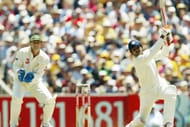
Going into the third Test of the Border-Gavaskar series in 2003, India were leading 1-0 and had a realistic chance of winning their first ever Test series in Australia. On the back of a famous victory at home in 2001, India were looking to overcome the mighty Aussies in their own backyard.
But playing at the MCG was always going to be tough and India chose to bat first. India’s openers – Aakash Chopra and Virender Sehwag – had both got off to good starts in the series, but had failed to make it count. The onus was on them to give India a good start and get a grip on the game.
After surviving a run-out chance early, Sehwag played watchfully for the first hour, especially against Nathan Bracken. Once the new ball started to lose its shine, Sehwag shifted gears. The floodgates opened in the 20th over, which saw Sehwag hitting Bracken for two boundaries.
Spin was introduced soon after, and Stuart McGill’s second ball disappeared for a six over extra cover. Ricky Ponting switched his bowlers around, but Sehwag was in his zone. McGill’s second over went for two boundaries, which prompted Ponting to bring in Brett Lee. Even he was not given any respite, as Sehwag drove, cut and slashed to his fifty on the stroke of lunch.
His hundred came off just 64 balls, and in typical Sehwag style, he hit a boundary on 99. If Australia thought that he would go slowly from there on, they were solely mistaken. Sehwag showed the full range of his shots as the sixes began to fly, even after the loss of two quick wickets.
After reaching his century, Sehwag scored 92 more runs off 89 balls, giving the Aussies no respite. From 189, he moved on to 195 with a six. He tried to repeat the stroke to reach his double-century but was caught on the boundary, ending a spectacular innings.
India went on to lose the match, thanks to a lacklustre performance in the second innings, but Sehwag’s innings will always be remembered as the one which frustrated the mighty Australians at home, something few batsmen have ever done. It is still the highest score by an Indian at the MCG.
#2 122 vs Chennai Super Kings, 2014
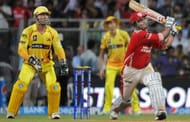
The Sehwag in 2014 was a far cry from the Sehwag in 2003. The footwork was still non-existent, but the hands had slowed down a bit. The uppercuts had reduced, and the booming drives were seldom seen. A pair of spectacles adorned his face, and there whispers of his fading form.
He had had an extremely low-key IPL till the encounter against CSK, with no display of his free-flowing style. Kings XI had found several match-winners in their team, and they had dominated the group stages throughout. After losing the first Qualifier against KKR, they were set to face former champions CSK in the second qualifier, where a win would give them a place in the final.
The stage was set, and it was a crucial game. CSK won the toss and put Punjab into bat, and Sehwag took strike. He took off in the very first over, slapping Nehra over cover. Mohit Sharma got the same treatment the next over as well.
Sehwag didn’t seem to show any sign of ‘old age’. Any question marks regarding luck were quickly dispatched in the next over, as Ishwar Pandey was hit for consecutive boundaries. Nehra came back and went for three more boundaries, and the first six was hit off Mohit Sharma. Spin was introduced, and Ashwin’s very first ball went straight back over his head.
Sehwag’s atrocious batting was taking a toll of MS Dhoni’s cool profile, and he started to switch bowlers every over, trying to trip the batsman up. But Sehwag was having none of it and reached his half-century off just 21 balls. Nehra was brought back again, and his first two balls disappeared over long-on.
Sehwag was unstoppable, and CSK were watching a masterful innings. Nobody was spared, and Sehwag took them all apart without mercy. His century came in 49 balls, and it was one of the most memorable innings in IPL history. There was more to come, as he hit Jadeja for 16 runs in three balls, before holing out to Nehra.
CSK were stunned into silence and the crowd went wild. Kings XI went on to win the match by 24 runs, and Sehwag ensured that no one would ever call him ‘old’
#3 83 vs. England at Chennai, 2008
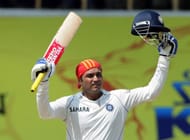
83 runs off 68 balls in a Test match – That’s what swung a match which was firmly in England’s grasp to India’s side. After being on top for three days and two sessions, England gave India an improbable target of 387 to win. Only six times in the history of the game had a side had scored more than 350 to win a match. A 300-run chase had never been done in India.
With the immense power of statistics on their side, the Englishmen enjoyed their tea on the fourth day of the first Test in Chennai. When they took the field, it was with the cold sense of purpose which preceded bowling the thought of bowling the opposition out. Naturally, they thought India would fold. At best, they would hold out for a draw. But England failed to take into account a crucial factor – Virender Sehwag.
The show began in the second over. Two fours off Anderson started his innings, and Sehwag became the highest run-scorer in 2008. Two more boundaries followed in the next over and India were 25/0 in just 3 overs.
If England still hadn’t realised Sehwag’s mindset, they would an over later. Sehwag hit Harmison for 14 runs in an over, and then smoked Monty Panesar over midwicket to bring up India’s 50 off 32 balls, at a run-rate of 9.38. Flintoff was brought in, and the scoring rate reduced. It seemed like Sehwag had abated.
India had reached 70/0 in 10 overs, which was a healthy run-rate in itself. But Sehwag was not finished. The first two balls of Panesar’s second spell went for 10 runs, before which Sehwag had reached his fifty – off 32 balls. Flintoff also disappeared as Sehwag chopped the ball past the slips to bring up India’s 100 – in 18 overs.
India had nonchalantly chased down 1/4th of the target in half a session and England were gobsmacked. The fans were in uproar and Sehwag looked like he would never stop. Graeme Swann was smashed over midwicket, and Sehwag reached the 80s. But the very next ball, he missed the paddle-sweep and was bowled, leaving India at 117/1 in just 23 overs.
India ended up winning the match thanks to Sachin’s century and Yuvraj’s half-century on the final day. But make no mistake, the chase would never have happened if Virender Sehwag – showing utter disregard for cricket history – had not gone after the English bowling line up. Sehwag’s knock proved to be the turning point of the match, and ultimately the series which India won 1-0.
#4 The 2011 World Cup
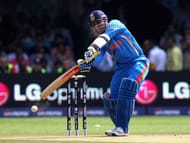
Yuvraj Singh’s all-round performance, Gautam Gambhir’s unsung half-centuries and MS Dhoni’s finishing six – these are all the memories that fans have of the 2011 World Cup, but they are woefully incomplete if Sehwag’s first ball boundaries are not included.
Having been a part of two unsuccessful World Cup campaigns already, Sehwag knew that this would be one of his last chances to get the trophy home. The fact that he was playing in the subcontinent powered him on, and he was determined to make it count.
Sehwag, always a superstitious man, believed that India should start every match with a boundary to ensure that they succeed in the tournament. For most batsmen, hitting the first ball of a match without even getting their eye in would have been a difficult task. Not for Sehwag.
India played Bangladesh in the World Cup opener in Dhaka, and thousands of people turned up to watch. The home side hoped for a repeat of the 2007 knockout, and the visitors wanted revenge. Play began and Shafiul Islam bowled it short and wide. Sehwag smacked it through the cover region and started the World Cup in the best way possible. He went on to make 175, assuring India an easy victory.
In their next match against England, Sehwag flashed outside off stump at James Anderson’s first delivery. It was edged and went through Graeme Swann at slip to give him yet another boundary. Sehwag was banking on divine intervention, and he seemed to be getting some.
By now, Indian fans knew what to expect off the first ball, and the crowd were backing Sehwag on. Against Ireland, the ball was pitched on a good length, but Sehwag rocked it through the off-side again. Sehwag scoring first-ball fours had become the stuff of legend, and it continued in the next match. Against Netherlands, a flick off his hips yielded yet another boundary off the first ball, and the crowd loved it.
Perhaps the biggest test was against South Africa in their penultimate group game. With Steyn taking the new ball, there were doubts as to whether the fun would continue. But it did. Steyn’s full-length ball was lofted over the fielder at mid-on, and Sehwag made it five in five.
Hopes of seeing six in six were dashed as Sehwag was rested for the next game, and he did not score boundaries off the first ball thereafter. But Sehwag’s luck had paid off, and his first-ball boundaries had worked well. India went on to lift the World Cup after 28 years, and all was well.
#5 125 vs New Zealand at Hamilton, 2009
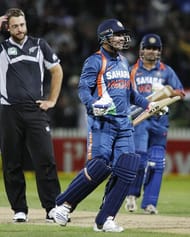
After an epic encounter at Christchurch in the third ODI, India were dealt a heavy blow as Sachin Tendulkar would be unavailable for the fourth ODI. This meant that Gautam Gambhir would open with Sehwag, and the Indian fans rued the missed opportunity of watching Tendulkar bat. Perhaps Sehwag was offended by this, and he went on to put up such a display that the New Zealanders would have been thoroughly wishing they’d never have to bowl at him again.
Chasing down a D/L target of 280 in 47 overs, India needed a brisk start. New Zealand’s bowling attack was a mix of experience and the lack thereof, but it would be difficult to score against them. Not for Sehwag, though. Starting by smashing debutant Ewen Thompson over midwicket, Sehwag made his intentions crystal clear. He hit him for a six and a four in his next over, prompting captain Daniel Vettori to push the fielders back on the leg side.
But Sehwag paid no heed, making room and crashing Kyle Mills through the offside. Iain O’Brien was brought on as first change and promptly disappeared for four boundaries in five balls and Sehwag opened up the entire field. In the next over, he brought up his fifty – off thirty-one balls. India were 75/0 in 9 overs.
Iain O’Brien was given another go and that over went for 13. Thompson was brought back and he conceded 16 – the debutant’s four over overs had gone for 42. Vettori was powerless against Sehwag’s stunning assault and was fast running out of bowlers. He brought himself on, and Sehwag smashed him over mid-on.
Jacob Oram’s third delivery landed beyond the midwicket boundary. It was absolute carnage. Sehwag had moved on to 97 and with another huge six – the Sehwag trademark – he reached his century off just 60 balls, then the fastest ODI century for India. Meanwhile, India had reached 165/0 in just 19 overs at a run-rate of 8.68. Their required run rate had gone to 4.08.
The Sehwag show continued. Oram’s full delivery was smashed back down, nearly taking Gambhir’s head off. Another fullish ball disappeared over long-off. Oram pitched it short and it went over midwicket. Then, a miracle happened. The gods, perhaps pitying the New Zealanders, opened up the heavens and the batsmen ran in.
India had reached 200 in just the 24th over. Their required run rate was below 2. They were awarded the match by the D/L method, and New Zealand finally heaved a sigh of relief. Sehwag later said in the press conference that he felt sorry for the bowlers and agreed quite frankly that there was nothing they could have done.
#6 293 vs Sri Lanka at Brabourne, 2009
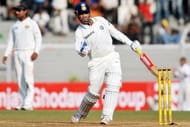
Seven runs – That was the margin by which Sehwag missed out on becoming the first man in Test history to score three triple-centuries. After his first two triples, Sehwag had not gotten a lot of chances to score another big one. He scored a double hundred against Sri Lanka at Galle but was unfortunately stranded at one end. So when India batted second in the first innings, Sehwag was determined to get that particular obstacle out of the way.
The pitch was good to bat on, which meant that Sri Lanka’s first innings score of 393 did not look very threatening. India put the prospect of losing early wickets to rest as Sehwag and Vijay put on a 200-run opening partnership – the latter slow and watchful, the former brash and unpredictable. Sri Lanka hoped that their premier spinner, that wily tweaker Muralitharan would help keep Sehwag down, but he failed miserably.
Tossed up balls were dispatched with ease, and the short balls were simply dismissed from his presence. Sehwag’s feet against the spinners were at their best, and he constantly reached out to the floated ball and slammed it past the infield. At one point, Sri Lanka kept a predominantly leg-side field and tried a negative line. No dice, as Sehwag made room and lofted balls over cover.
His innings could only be described as awe-inspiring, especially when you take into account that the most number of deliveries he went without scoring a boundary was 12. There were 14 fours and four sixes before his first hundred, and 26 more fours and 3 sixes would be added to that tally. Sehwag alone scored 284 runs on day 2, and went back determined to be the world-record holder for most triple centuries in a career.
But just in the fourth over of the third day, he offered one back to Murali, who gleefully accepted it. It was a bad shot – a lapse in concentration. Sehwag stood disbelievingly, tucked his bat under his arm and walked away. Sri Lanka had been stunned into submission, and India’s humongous 726 helped them take the match by an innings. It would always be remembered as the match that Virender Sehwag almost reached his third triple century.
#7 219 vs West Indies at Indore, 2011
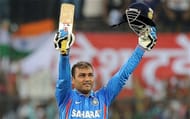
Sehwag had it all - a World T20 medal, a World Cup medal and a Champions Trophy medal. He had some cool personal records too – two triple centuries, eleven scores of 150 of or more in Tests and even the fastest ODI hundred by an Indian. But even then, Sehwag yearned for more. He wanted the biggest of all ODI achievements – the ODI double hundred. A year ago, batting maestro had added it to his vast collection, becoming the first man to reach the milestone. Ever since, Sehwag also wanted to emulate his idol.
He got close two times previously – 146 against Sri Lanka and a 175 against Bangladesh and wasn’t going to let it slide again. Facing a relatively weak West Indies bowling attack at a belter at Indore, Sehwag was in the zone. Starting off by hitting his second ball for four, Sehwag batted like a man possessed. He hit a six in the next over and a boundary in the next, bringing up India’s fifty in 9 overs.
Narine was brought in after the powerplay, and his first delivery ended up behind the sightscreen. Another six followed in the next over and in the over after that as Sehwag ruthlessly pounded all the bowlers at will. India’s first 50 came up in 50 balls, their next 50 in 37.
Bowlers were changed every over, but the run flow did not stop. Sehwag treated them all with equal indifference as the bad balls were gone the minute they were in his arc. India went past 150 in the 21st over, and the first signs that Sehwag could make a big hundred were clearly seen. Pollard went for 14 and Russell for 10 as Sehwag reached his century off 69 balls.
Though he lost his partner the very next ball, he never wavered from his approach. Raina was sent in to up the ante, and he responded well, taking the strike off Sehwag and giving him time to rest. This would prove crucial in the coming overs. Sehwag took a special liking for Narine as he made room and smashed him for consecutive fours. He repeated the feat against Marlon Samuels as well, bringing up his 150 in the process.
With over 14 overs left in the game, there was no doubt Sehwag was going for the big double. The batting powerplay was taken, and Andre Russell was smacked over midwicket. Ravi Rampaul’s harmless leg cutters were dispatched as well, as were Kemar Roach’s fast in-swingers. The West Indians were perplexed, as Sehwag moved from 150 to 190 in just 22 balls. The nerves were telling in the crowd and the dressing room, but Sehwag seemed fresh as a daisy.
A flick over fine leg brought him to 196, one hit away. The field was brought up, and the pace was taken off the ball. Russell bowled it outside off, and Sehwag’s wonderful hands accepted the gift gleefully. He had become the second man to reach the ODI double, and was India’s highest scorer in ODI cricket, to add to the same record in Tests.
It still wasn’t over. There was an uppercut six two balls later and then a smack over mid-off. Another tickle to fine leg brought him to 219, but the very next ball saw him hole out to long-off. It was just the 47th over. The West Indians congratulated him on a terrific knock, and the fans were on their feet. As Sehwag walked off, he had yet another record under his belt, and perhaps his best kncok in ODIs.
#8 319 vs South Africa at Chennai, 2008
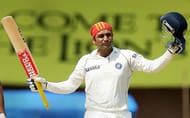
Chennai has seen its fair share of epic Test matches. The second-ever tied Test was played there, and then it was home to Narendra Hirwani’s 16-wicket haul on debut. It also featured a Sehwag special in 2010 and then saw Mahendra Singh Dhoni hit a double-century in 2013. But more than any of these, perhaps the most special Test that remains in the hearts of the Chennai crowd would be Virender Sehwag’s second triple century in Tests.
In the first Test of the three-match series, South African captain Graeme Smith saw a flat track and chose to bat first. It proved a good decision as they racked up 540 on the board in under five sessions. They let India bat shortly after tea, knowing that the score was above par. There was a good chance they could bowl India out soon, and even a smidgeon of an opportunity to enforce the follow-on. With high hopes, South Africa proceeded to bowl. Sehwag destroyed those hopes with cold efficiency.
In Sehwag’s terms, having a look-in lasted exactly four balls. His fifth went for four, his sixth sailed over third man for six. South Africa blanched. Never before in living memory had anyone hit a six against them in the second over of a Test match. There were fours every other over, but overall it was a watchful innings. India went back into the pavilion at 82/0 at stumps.
The third day was a run fest. Sehwag, who was earlier dropped from the Test side laid into the South African bowling with audacity, showing off his range of shots. An astonishing 133 runs came in the square region on the off-side, his favourite position. South Africa’s plan of bowling outside off and full did not pay off in the least as Sehwag played fearlessly. The cuts and drives kept coming, and the boundaries started to flow.
Paul Harris, the spinner got the most punishment as 100 runs were hit off his 108 deliveries, including quite a few reverse sweeps. The short balls on off stump failed to work as Sehwag uppercut with ease, at times beating and even clearing the fielder in the deep. South Africa tried to move the line to off and middle, but Sehwag was up to the task again, swivelling and glancing the ball off his hips.
The four-pronged pace attack of Steyn, Morkel, Ntini and Kallis were dispatched one by one as Sehwag reigned supreme. Sehwag outscored his partners in every single partnership, often scoring more than half all by himself. When he reached his triple-century, he was the fastest in terms of balls, a record he would have broken had he gotten his third in Brabourne against Sri Lanka.
It was Sehwag’s day as South Africa saw their chances of enforcing the follow-on bite the Chennai dust, as Sehwag scored 319 all by himself. His strike-rate left people awe-struck, and at one point, he went from 175 to 200 in 8 balls. Between 150 and 250, he scored at a strike rate of 150.00 and when he reached his triple, it was off 278 balls. Sehwag proved that he could hold his own against the best of attacks, and when he did, the world trembled before him.
#9 309 vs. Pakistan at Multan 2004
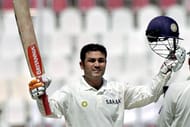
While every cricket fan knows that Sehwag holds two triple centuries, very few know that both innings started on consecutive days, four years apart. Before Sehwag reached his second triple on March 30, 2008, he had already scored one nearly exactly four years ago, on March 29, 2004. On a flat and lifeless pitch on Multan, India chose to bat first. Under the sweltering heat, the Pakistan bowlers hoped for early wickets to get some respite.
Unable to get much purchase, Pakistan decided to bowl close to the stumps and wait for the batsmen to make mistakes. Sehwag joined with the passive Aakash Chopra to kill any aggression the Pakistani bowlers had. Akhtar's pace, Sami’s bite and Shabbir’s bounce did nothing to the batsmen as the blocked and drove with style. Sehwag was obviously the aggressor as he began the second over with a boundary.
Shabbir Ahmed was greeted with consecutive boundaries, and as India passed 50 runs, Pakistan’s shoulders already slumped. The first six of the match was courtesy Sehwag, as he took eleven runs off Ahmed’s fifth. Spin made no difference as Saqlain Mushtaq went for 15, and India reached 100 in 29 overs, Sehwag scoring 72 of those.
After he moved on to 99, a six off Shoaib Akhtar gave him his century, off a mere 107 balls. The quick dismissals of Aakash Chopra and Dravid did not faze him, as he moved through the scores in double-quick time. With Tendulkar keeping good company, Sehwag hit another six off Saqlain and three more boundaries off Shabbir to move to 150.
The innings was not without luck, as he was dropped twice. He made the most of it though, as he reached his first ever double century off 222 balls, having spent 10 balls on 199, a small moment of tension. Sehwag was till riled that he got out on 195 at Melbourne, and it showed on the second day. Sehwag stated at the press conference that he’d like to go for the 300, and he did it precisely.
As Sehwag went past Laxman’s 281, the crowd was up on their feet. On 295, the crowd expected him to see off the good balls again, wait for the historic moment. But nobody tells Sehwag what to do. He launched Saqlain into the stands at midwicket and raised his arms, as the crowd went crazy, both in the stands and in the whole of India. Sehwag had become India’s first – and to date, only – triple centurion in Test match cricket.
#10 201* vs. Sri Lanka at Galle, 2008
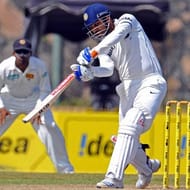
Surprisingly, in a career dominated by aggressiveness, strikes rates above 100 and mad max batting, it is one of Sehwag’s more patient innings that he deems his best. After a hiding at the SSC Colombo in the first Test, India was under pressure to mount a comeback in the second Test at Galle. The fact that Galle was one of Sri Lanka’s most successful grounds would also play against them.
India would always have to bowl last to win, and they got lucky when they won the toss. Anil Kumble immediately chose to bat. One look at the pitch and India knew this would be no belter. They had to wait for the bad balls and curb their strokes. In short, they had to play “ugly cricket”. But Sehwag didn’t play by the rules as he and Gambhir combined to get yet another 100-run opening partnership.
Sehwag wasn’t as aggressive as usual, but he was still whacking the ball as hard as he ever did. Gambhir departed with the score at 167, and before you could blink, 167-1 became 178-4.
In the first Test, Sehwag had played a poor shot and India had collapsed dramatically. With Sehwag’s unpredictability in mind, a repeat was on the cards. But Sehwag played the watchful game. To spectator’s eyes, it was an unbelievable thing. Virender Sehwag, who hit every ball he could reach, who smacked sixes over third man, was playing cautiously. In what proved to be Sehwag’s day, he stroked the singles and even ran a double once or twice.
Of course, the bad balls were always punished. There was a small partnership with Laxman, which kept India going. Sri Lanka didn’t attack as much as they should have, which helped Sehwag. With wickets falling in heaps around him, Sehwag kept his head down and batted unfazed. Murali and Mendis tried their best to weave webs of magic around him, but Sehwag motored on.
All in all, he scored 128 off the spinners, and he was never bogged down. The sixes also came, but with lesser frequency. A straight hit off a googly was perhaps the best. At one point, India was at 318/8, with Sehwag still on 192*. It seemed he would miss his double-century. But Zaheer wisely kept the next two balls down, and Sehwag breathed again.
Sehwag still didn’t go for the big shots. He kept defending, trying to increase the score run by run. Then again, tragedy struck. Zaheer got out, leaving India 9 down, and Sehwag at 194. Sehwag still didn’t go for the big shots, blocking most and taking the singles one by one. And after 27 balls in the 190s – an age for Sehwag – he reached his double century.
It wasn’t a blitz-fest. It was an audacious display of strokeplay. It was a gritty innings of substance which kept India together. Sehwag would remain not-out and become the second Indian batsmen to carry his bat after Sunil Gavaskar. India went on to win an epic match, and Sehwag had become even more of a legend than he already was.
Follow IPL Auction 2025 Live Updates, News & Biddings at Sportskeeda. Get the fastest updates on Mega-Auction and cricket news
